Home | Category: Science / Science and Philosophy
ARCHIMEDES AND HIS INVENTIONS
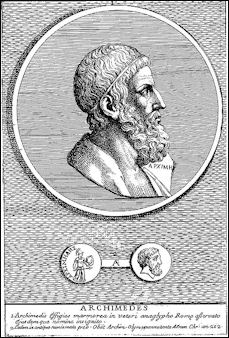 Archimedes (287-212 B.C.) may have been the greatest inventor of all time. He invented the compound pulley and the Archimedes screw and explained the theory of the lever, and said that if he could find one long enough and a prop strong enough he could lift the entire world, or in his words, “Give me a place to stand, and I will move the Earth.”
Archimedes (287-212 B.C.) may have been the greatest inventor of all time. He invented the compound pulley and the Archimedes screw and explained the theory of the lever, and said that if he could find one long enough and a prop strong enough he could lift the entire world, or in his words, “Give me a place to stand, and I will move the Earth.”
He was also a great scientist and mathematician, among other things estimating the value of pi and conducted the first mathematic discussion of infinity. According to legend when he discovered the concept of specific gravity — the idea that objects of the same material and the same weight will displace the same amount of water — while he was taking a bath he was so excited he jumped out of his bathtub and ran through the streets nude shouting "Eureka! Eureka!"
William Noel, a curator of ancient manuscripts at the Walter Art Museum in Baltimore, told Smithsonian magazine, “Archimedes was the greatest mathematician in the ancient world. He was the first scientist to apply abstract mathematical principals to the world around him.”
The Archimedes screw is a devise that moves water up hill. It is still widely used in rural Egypt to raise water from a lower irrigation ditch to a higher one. An Archimedes screw used today in agriculture is about six feet long and a foot wide. It is made of wood and resembles a large drill bit. Placed inside steel tube, angled so it is a little less than vertical to the ground, and turned by a hand crank, the device draws water uphill at a slight incline. Cranked from dawn until dusk the ingenious but primitive tool draws enough water irrigate a half an acre of land.
Categories with related articles in this website: Ancient Greek and Roman Philosophy and Science (33articles) factsanddetails.com; Ancient Greek and Roman Religion and Myths (35 articles) factsanddetails.com; Ancient Greek History (48 articles) factsanddetails.com; Ancient Greek Art and Culture (21 articles) factsanddetails.com; Ancient Greek Life, Government and Infrastructure (29 articles) factsanddetails.com; Early Ancient Roman History (34 articles) factsanddetails.com; Later Ancient Roman History (33 articles) factsanddetails.com; Ancient Roman Life (39 articles) factsanddetails.com; Ancient Roman Art and Culture (33 articles) factsanddetails.com; Ancient Roman Government, Military, Infrastructure and Economics (42 articles) factsanddetails.com
Websites on Ancient Greece and Rome:
Internet Ancient History Sourcebook: Greece sourcebooks.fordham.edu ; Internet Ancient History Sourcebook: Hellenistic World sourcebooks.fordham.edu ; BBC Ancient Greeks bbc.co.uk/history/; Canadian Museum of History historymuseum.ca; Perseus Project - Tufts University; perseus.tufts.edu ; ; Gutenberg.org gutenberg.org;
British Museum ancientgreece.co.uk;
Illustrated Greek History, Dr. Janice Siegel, Department of Classics, Hampden–Sydney College, Virginia hsc.edu/drjclassics ;
The Greeks: Crucible of Civilization pbs.org/empires/thegreeks ;
Oxford Classical Art Research Center: The Beazley Archive beazley.ox.ac.uk ;
Ancient-Greek.org ancientgreece.com;
Metropolitan Museum of Art metmuseum.org/about-the-met/curatorial-departments/greek-and-roman-art; The Ancient City of Athens stoa.org/athens;
The Internet Classics Archive kchanson.com ; Internet Ancient History Sourcebook: Rome sourcebooks.fordham.edu ; Internet Ancient History Sourcebook: Late Antiquity sourcebooks.fordham.edu ; Forum Romanum forumromanum.org ;
“Outlines of Roman History” forumromanum.org; “The Private Life of the Romans” forumromanum.org|; BBC Ancient Rome bbc.co.uk/history;
The Roman Empire in the 1st Century pbs.org/empires/romans;
The Internet Classics Archive classics.mit.edu ;
Bryn Mawr Classical Review bmcr.brynmawr.edu;
De Imperatoribus Romanis: An Online Encyclopedia of Roman Emperors roman-emperors.org;
Cambridge Classics External Gateway to Humanities Resources web.archive.org/web;
Ancient Rome resources for students from the Courtenay Middle School Library web.archive.org ;
History of ancient Rome OpenCourseWare from the University of Notre Dame /web.archive.org ;
United Nations of Roma Victrix (UNRV) History unrv.com
Archimedes’s Life and Works

Archimedes lever
Archimedes was born and spent most of his life in Syracuse on Sicily. To save his hometown from a Roman invasion, Archimedes invented a machine that, according to Plutarch, had huge iron claws that came out from city walls overlooking the harbor and plucked ship from the sea, shook out the sailors, and then tossed the ships on jagged rocks. The ships the machines couldn't lift were burned with mirrors that intensified and focused the rays of the sun. Archimedes also invented machines that hurled stone balls at advancing troops. Reportedly these machines held off Roman attacks for eight months.
Archimedes wrote “On the Method of Mathematical Theorems” , “On Floating Bodies” , “On the Measurement of the Circle” , “On the Sphere and the Cylinder”, “On Spiral Lines” and “On the Equilibrium of Planes” .
In “On the Method of Mathematical Theorems” , Archimedes uses the way an object can be balanced to derive its geometric and physical properties and discusses infinity, an idea which was thought by many to have been first really explored in age of Sir Isaac Newton. The work also contains a piece called “Stomachion”, arguably the first treatise on combinatronics, a branch of mathematics that is concerned with the organization of elements within sets. In this piece Archimedes described a puzzle in which a square is cut into 14 irregular pieces . The solution lies in determining the number of ways the pieces can be arranged back into a square.
Archimedes Amazing Machines in Action During Roman Siege of Syracuse in 212 B.C.
Describing Archimedes machines in action during the Roman invasion and siege of the Greek colony Syracuse in Sicily in 212 B.C., Plutarch wrote in his account of Marcus Claudius Marcellus: “The land forces were conducted by Appius: Marcellus, with sixty galleys, each with five rows of oars, furnished with all sorts of arms and missiles, and a huge bridge of planks laid upon eight ships chained together, upon which was carried the engine to cast stones and darts, assaulted the walls, relying on the abundance and magnificence of his preparations, and on his own previous glory; all which, however, were, it would seem, but trifles for Archimedes and his machines. [Source: Plutarch, Marcellus (legendary, died 208 B.C.E.), 75 A.C.E., translated by John Dryden]
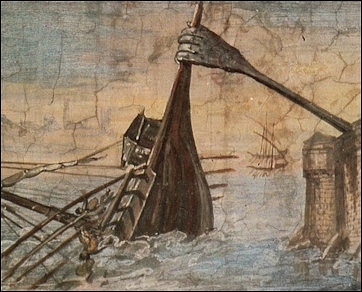
Archimedes claw
“These machines he had designed and contrived, not as matters of any importance, but as mere amusements in geometry; in compliance with King Hiero's desire and request, some little time before, that he should reduce to practice some part of his admirable speculation in science, and by accommodating the theoretic truth to sensation and ordinary use, bring it more within the appreciation of the people in general. Eudoxus and Archytas had been the first originators of this far-famed and highly-prized art of mechanics, which they employed as an elegant illustration of geometrical truths, and as means of sustaining experimentally, to the satisfaction of the senses, conclusions too intricate for proof by words and diagrams. As, for example, to solve the problem, so often required in constructing geometrical figures, given the two extremes, to find the two mean lines of a proportion, both these mathematicians had recourse to the aid of instruments, adapting to their purpose certain curves and sections of lines. But what with Plato's indignation at it, and his invectives against it as the mere corruption and annihilation of the one good of geometry, which was thus shamefully turning its back upon the unembodied objects of pure intelligence to recur to sensation, and to ask help (not to be obtained without base supervisions and depravation) from matter; so it was that mechanics came to be separated from geometry, and, repudiated and neglected by philosophers, took its place as a military art.
“Archimedes, however, in writing to King Hiero, whose friend and near relation he was, had stated that given the force, any given weight might be moved, and even boasted, we are told, relying on the strength of demonstration, that if there were another earth, by going into it he could remove this. Hiero being struck with amazement at this, and entreating him to make good this problem by actual experiment, and show some great weight moved by a small engine, he fixed accordingly upon a ship of burden out of the king's arsenal, which could not be drawn out of the dock without great labour and many men; and, loading her with many passengers and a full freight, sitting himself the while far off, with no great endeavour, but only holding the head of the pulley in his hand and drawing the cords by degrees, he drew the ship in a straight line, as smoothly and evenly as if she had been in the sea. The king, astonished at this, and convinced of the power of the art, prevailed upon Archimedes to make him engines accommodated to all the purposes, offensive and defensive, of a siege. These the king himself never made use of, because he spent almost all his life in a profound quiet and the highest affluence. But the apparatus was, in most opportune time, ready at hand for the Syracusans, and with it also the engineer himself.”
Ships Lifted Out of Sea and Rolled To and Fro by Archimedes Machines

model of Archimedes shipshake
Plutarch wrote:“When, therefore, the Romans assaulted the walls in two places at once, fear and consternation stupefied the Syracusans, believing that nothing was able to resist that violence and those forces. But when Archimedes began to ply his engines, he at once shot against the land forces all sorts of missile weapons, and immense masses of stone that came down with incredible noise and violence; against which no man could stand; for they knocked down those upon whom they fell in heaps, breaking all their ranks and files. [Source: Plutarch, Marcellus (legendary, died 208 B.C.E.), 75 A.C.E., translated by John Dryden]
In the meantime huge poles thrust out from the walls over the ships sunk some by the great weights which they let down from on high upon them; others they lifted up into the air by an iron hand or beak like a crane's beak and, when they had drawn them up by the prow, and set them on end upon the poop, they plunged them to the bottom of the sea; or else the ships, drawn by engines within, and whirled about, were dashed against steep rocks that stood jutting out under the walls, with great destruction of the soldiers that were aboard them. A ship was frequently lifted up to a great height in the air (a dreadful thing to behold), and was rolled to and fro, and kept swinging, until the mariners were all thrown out, when at length it was dashed against the rocks, or let fall.
At the engine that Marcellus brought upon the bridge of ships, which was called Sambuca, from some resemblance it had to an instrument of music, while it was as yet approaching the wall, there was discharged a piece of rock of ten talents weight, then a second and a third, which, striking upon it with immense force and a noise like thunder, broke all its foundation to pieces, shook out all its fastenings, and completely dislodged it from the bridge. So Marcellus, doubtful what counsel to pursue, drew off his ships to a safer distance, and sounded a retreat to his forces on land. They then took a resolution of coming up under the walls, if it were possible, in the night; thinking that as Archimedes used ropes stretched at length in playing his engines, the soldiers would now be under the shot, and the darts would, for want of sufficient distance to throw them, fly over their heads without effect. But he, it appeared, had long before framed for such occasions engines accommodated to any distance, and shorter weapons; and had made numerous small openings in the walls, through which, with engines of a shorter range, unexpected blows were inflicted on the assailants.”
Archimedes Elated as Romans Flee from His Powerful Machines
Plutarch wrote: “Thus, when they who thought to deceive the defenders came close up to the walls, instantly a shower of darts and other missile weapons was again cast upon them. And when stones came tumbling down perpendicularly upon their heads, and, as it were, the whole wall shot out arrows at them, they retired. And now, again, as they were going off, arrows and darts of a longer range inflicted a great slaughter among them, and their ships were driven one against another; while they themselves were not able to retaliate in any way. For Archimedes had provided and fixed most of his engines immediately under the wall; whence the Romans, seeing that indefinite mischief overwhelmed them from no visible means, began to think they were fighting with the gods. [Source: Plutarch, Marcellus (legendary, died 208 B.C.E.), 75 A.C.E., translated by John Dryden]
“Yet Marcellus escaped unhurt, and deriding his own artificers and engineers, "What," said he, "must we give up fighting with this geometrical Briareus, who plays pitch-and-toss with our ships, and, with the multitude of darts which he showers at a single moment upon us, really outdoes the hundred-handed giants of mythology?" And, doubtless, the rest of the Syracusans were but the body of Archimedes's designs, one soul moving and governing all; for, laying aside all other arms, with this alone they infested the Romans and protected themselves. In fine, when such terror had seized upon the Romans, that, if they did but see a little rope or a piece of wood from the wall, instantly crying out, that there it was again, Archimedes was about to let fly some engine at them, they turned their backs and fled, Marcellus desisted from conflicts and assaults, putting all his hope in a long siege.

Archimedes directing the defenses of Syracuse
“Yet Archimedes possessed so high a spirit, so profound a soul, and such treasures of scientific knowledge, that though these inventions had now obtained him the renown of more than human sagacity, he yet would not deign to leave behind him any commentary or writing on such subjects; but, repudiating as sordid and ignoble the whole trade of engineering, and every sort of art that lends itself to mere use and profit, he placed his whole affection and ambition in those purer speculations where there can be no reference to the vulgar needs of life; studies, the superiority of which to all others is unquestioned, and in which the only doubt can be whether the beauty and grandeur of the subjects examined, of the precision and cogency of the methods and means of proof, most deserve our admiration. It is not possible to find in all geometry more difficult and intricate questions, or more simple and lucid explanations. Some ascribe this to his natural genius; while others think that incredible effort and toil produced these, to all appearances, easy and unlaboured results. No amount of investigation of yours would succeed in attaining the proof, and yet, once seen, you immediately believe you would have discovered it; by so smooth and so rapid a path he leads you to the conclusion required. And thus it ceases to be incredible that (as is commonly told of him) the charm of his familiar and domestic Siren made him forget his food and neglect his person, to that degree that when he was occasionally carried by absolute violence to bathe or have his body anointed, he used to trace geometrical figures in the ashes of the fire, and diagrams in the oil on his body, being in a state of entire preoccupation, and, in the truest sense, divine possession with his love and delight in science. His discoveries were numerous and admirable; but he is said to have requested his friends and relations that, when he was dead, they would place over his tomb a sphere containing a cylinder, inscribing it with the ratio which the containing solid bears to the contained. Such was Archimedes, who now showed himself, and so far as lay in him the city also, invincible. “
Archimedes, Letter to Dositheus, c. 220 B.C.:
Archimedes wrote in around 220 B.C.: “Archimedes to Dositheus, greeting: Formerly I sent to you the studies which I had finished up to that time together with the demonstrations, which were to show that a segment bounded by a straight line and a conic section is four-thirds of the triangle on the same base as the segment and of the same height. Since that time certain propositions as yet undemonstrated have come to my mind, and I have undertaken to work them out. These are: 1. The surface of any sphere is four times the surface of its greatest circle; 2. The surface of any segment of a sphere is equal to the surface of that circle the radius of which equals the straight line drawn from the vertex of the segment to the circumference of the circle which serves as the base of the segment; 3. That a cylinder with a base equal to the great circle of a given sphere, and a height equal to the diameter of thesphere contains half the volume of that sphere and its surface is equal to half the surface of that sphere. [Source: Oliver J. Thatcher, ed., “The Library of Original Sources” (Milwaukee: University Research Extension Co., 1907), Vol. III: The Roman World, pp. 286-292]
“These propositions, of course, were always true of these figures, but they were hidden to the men who studied geometry before my time. Therefore, since I have discovered that these things hold true of these figures I do not fear to place them alongside my own previous results and the most thoroughly established theorems of Eudoxus, such as: any pyramid is equal to one-third of the prism of the same base and height, and any cone is equal to one-third of the cylinder of the same base and height.
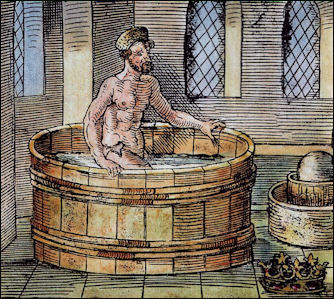
Eureka “First Postulate. Supposed that a fluid is of such a character that when its component parts are undisturbed and in immediate contact the part which is subject to the less pressure is moved by the part which is subject to the greater pressure; and that each part is forced in a perpendicular direction by the part above, if the fluid is compressed.
“Proposition 1. If a surface is always cut by a plane passing through a given point, and if the section thus formed is always a circle whose center is the given point, the surface is that of.a sphere. Proposition 2. The surface of any still fluid is always the surface of a sphere whose center is the center of the earth. Proposition 3. Those solids which are of the same weight as a fluid in proportion to their size, when sunk in that fluid will be submerged in such a way that they neither extend above that fluid nor sink below it.
“Proposition 4. A solid which is lighter than a given fluid will not sink below the surface when placed in that fluid, but part of it will extend above the surface. Proposition 5. A solid lighter than a given fluid will, when placed in that fluid, be so far submerged that the weight of the solid will B.C. equal to the weight of the fluid displaced. Proposition 6. If a solid lighter than a given fluid be forced into lhat fluid the solid will be driven upwards again by a force which is equal to the difference between the weight of the fluid and the weight of the amount of fluid displaced.
“Second Postulate: If a solid lighter than a given fluid rest in that fluid the weight of the solid to the weight of an equal volume of the fluid will be as the part of the solid which is submerged is to the whole solid.” Mathematics
According to the Canadian Museum of History: “The Greeks had great success in the areas of mathematics, particularly geometry, borrowing heavily from the Egyptians (who were concerned primarily with practical applications) while raising the theoretical and intellectual bar to new heights. Euclid's classic book on the Elements of Geometry was the world's main textbook for almost two millennia. [Source: Canadian Museum of History historymuseum.ca |]
Death of Archimedes
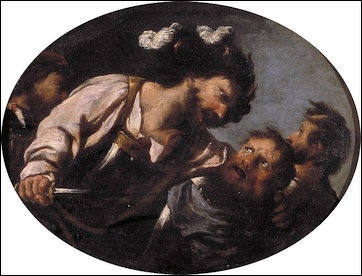
death of Archimedes
Archimedes was assassinated at the age of 75 by the Romans for his anti-Roman activities. In one account of his death he was so absorbed in a mathematical problem he failed to notice that Syracuse had been sacked and see the Roman soldier who drove a sword through him. In another story he was found make geometric designs in the sand and said, as he was being killed, “Don’t disturb my circles.” In any case, Archimedes was granted his last request: that a sphere and cylinder be placed on his tombstone.◂
Plutarch wrote: “But nothing afflicted Marcellus so much as the death of Archimedes, who was then, as fate would have it, intent upon working out some problem by a diagram, and having fixed his mind alike and his eyes upon the subject of his speculation, he never noticed the incursion of the Romans, nor that the city was taken. In this transport of study and contemplation, a soldier, unexpectedly coming up to him, commanded him to follow to Marcellus; which he declining to do before he had worked out his problem to a demonstration, the soldier, enraged, drew his sword and ran him through.
“Others write that a Roman soldier, running upon him with a drawn sword, offered to kill him; and that Archimedes, looking back, earnestly besought him to hold his hand a little while, that he might not leave what he was then at work upon inconclusive and imperfect; but the soldier, nothing moved by his entreaty, instantly killed him. Others again relate that, as Archimedes was carrying to Marcellus mathematical instruments, dials, spheres, and angles, by which the magnitude of the sun might be measured to the sight, some soldiers seeing him, and thinking that he carried gold in a vessel, slew him. Certain it is that his death was very afflicting to Marcellus; and that Marcellus ever after regarded him that killed him as a murderer; and that he sought for his kindred and honoured them with signal favours.”
Archimedes Palimpsest
Archimedes works were originally written on papyrus and the originals have now been lost. But over the centuries the originals were faithfully copied and recopied by generations of scribes and made their way to parchment around the A.D. 5th century. All of these works have also been lost.
The Archimedes Palimpsest is a 174-page 1,000-year-old book made of goatskin that is about the size of a hardback book. Comprised of very fragile pages made of paper that had been burned and torn and have spots of purple mold on them, it contains two Archimedes works — “On the Method of Mathematical Theorems” and another in the original Greek — that are regarded as the closet copies of Archimedes originals, something that makes unique and very valuable. The Archimedes Palimpsest is the only copy of Archimedes work, which contains his final proofs and explanations of his discoveries. [Source: Mary K. Miller, Smithsonian magazine, March 2007]

Archimedes screw The Archimedes Palimpsest is believed to have originated in the A.D. 900s and was kept at the main library in Constantinople. It survived the sacking of that city by Crusaders in 1206 and later made its way to a Christian monastery in Bethlehem. In 1229, a Greek priest who needed the durable and valuable vellum for a liturgical work took the Archimedes work apart, scraped and washed the pages and copied liturgical texts on them, a process known as palmiseting. As awful as this sounds the original text probably would not have survived had the priest not done this and subsequent monks not taken measure preserve it. Palimpsest is pronounced “PAL-imp-sest” and is Greek for “rubbed again”).
The palimpsest was then lost until it was rediscovered in a Greek Orthodox monastery in Istanbul (Constantinople) by a Danish classics scholar, Johan Ludwig Heiberg, in 1906. He recognized some of faint writing as the work of Archimedes and photographed many of the pages and wrote some scholarly articles about them. Then work disappeared again, under mysterious circumstances (it was possibly stolen) is thought to have been in the hands of a French family for much of the 20th century.
In 1998, the work resurfaced and was sold for $2.2 mullion at a Christie's auction. The owner remain anonymous but has allowed scientists to study it and photograph it. Of particular significance is the fact the owner has allowed the work to be X-rayed with advanced equipment at Stanford’s Synchrotron Radiation Laboratory using a device that produces powerful beams of electrons that race around a 260-foot-in-diameter ring at the speed of light and pick up iron found in the original ink under gold lief used in a forgery attempt. Just taking the book apart and cleaning and restoring it for the imaging took four years. Using ultraviolet light and various methods to enhance images, scientists from Johns Hopkins and the Rochester Institute of Technology were able to reveal about 80 percent of the manuscript’s contents.
Abigail Quandt, the senior conservator of manuscripts and rare books; and specialists in imaging techniques, told the New York Times she took almost four years to take the palimpsest apart. Some pages of the text were laid on a table where fiber optic lights on either side revealed aspects of the manuscript. Ultraviolet, strobe and tungsten lights were used to enhance the visibility of the text. After computer processing, the hypertext appeared red, and the prayer book text appeared black.
Contents of the Archimedes Palimpsest
The Archimedes Palimpsest is best known for containing some of the oldest copies of work by the great Greek mathematician who gives the manuscript its name. But there is more to the palimpsest than Archimedes’ work, including 10 pages of Hyperides, offering tantalizing and fresh insights into the critical battle of Salamis in 480 B.C., in which the Greeks defeated the Persians, and the battle of Chaeronea in 338 B.C., which spelled the beginning of the end of Greek democracy. [Source: Felicia R. Lee, New York Times, November 27, 2006]
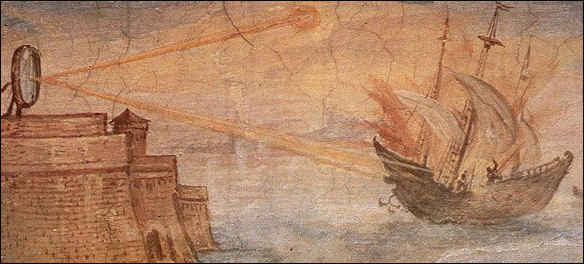
Archimedes Mirror weapon
“This book is the most important palimpsest in the world,” William Noel, the curator of manuscripts and rare books at the Walters Art Museum here and the director of the Archimedes Palimpsest project, told the New York Times. “We’re learning about the nuts and bolts of ancient medieval history and gaining a new understanding of the early history of the calculus and of our understanding of ancient physics. The prayer book is made up of five other books. Another of these books seems to be an early Christian — second or third century — commentary on ancient views of the soul and why they were incorrect.”
The palimpsest contains about 120 printed pages of Archimedes text, in addition to the Hyperides material, a philosophical commentary on Aristotle, a neo-Platonic philosophical text, pages from a liturgical book on the life of a saint and at least five pages so well-erased it is impossible to determine what they are, Noel told the New York Times. The mystery of Archimedes’ treatise on combinatorics, the Stomachion, was solved in 2003 by deciphering the palimpsest.
Image Sources: Wikimedia Commons, The Louvre, The British Museum
Text Sources: Internet Ancient History Sourcebook: Greece sourcebooks.fordham.edu ; Internet Ancient History Sourcebook: Hellenistic World sourcebooks.fordham.edu ; BBC Ancient Greeks bbc.co.uk/history/ ; Canadian Museum of History historymuseum.ca ; Perseus Project - Tufts University; perseus.tufts.edu ; MIT, Online Library of Liberty, oll.libertyfund.org ; Gutenberg.org gutenberg.org Metropolitan Museum of Art, National Geographic, Smithsonian magazine, New York Times, Washington Post, Los Angeles Times, Live Science, Discover magazine, Times of London, Natural History magazine, Archaeology magazine, The New Yorker, Encyclopædia Britannica, "The Discoverers" [∞] and "The Creators" [μ]" by Daniel Boorstin. "Greek and Roman Life" by Ian Jenkins from the British Museum.Time, Newsweek, Wikipedia, Reuters, Associated Press, The Guardian, AFP, Lonely Planet Guides, “World Religions” edited by Geoffrey Parrinder (Facts on File Publications, New York); “History of Warfare” by John Keegan (Vintage Books); “History of Art” by H.W. Janson Prentice Hall, Englewood Cliffs, N.J.), Compton’s Encyclopedia and various books and other publications.
Last updated October 2018
